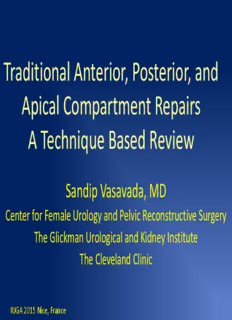
Traditional Anterior, Posterior, and Apical Compartment Repairs A Technique Based Review PDF
Preview Traditional Anterior, Posterior, and Apical Compartment Repairs A Technique Based Review
Traditional Anterior, Posterior, and Apical Compartment Repairs A Technique Based Review Sandip Vasavada, MD Center for Female Urology and Pelvic Reconstructive Surgery The Glickman Urological and Kidney Institute The Cleveland Clinic IUGA 2015 Nice, France “Traditional repairs vs Augmented repairs” Should we abandon “traditional repairs”? If no, then what situations to use – First time occurrence of prolapse – Thin tissues/ atrophic – Sexually active patients? Constant need to “innovate” or “keep up” Is this because traditional repairs are doomed to failure……. Challenges in Vaginal Prolapse Surgery Anterior Vaginal Wall Prolapse Apical Prolapse – At time of hysterectomy – Post-hysterectomy Posterior Vaginal Wall Prolapse Anterior Vaginal Wall Prolapse Four Defects of Anterior Vaginal Wall Prolapse Repair of central defect – re-approximation of widened pubocervical fascia Repair of lateral defect – Suspension/support of bladder base and apex Urethra and BN support – vaginal sling (if necessary), same or separate incision Cardinal ligament repair/ Bladder base/ Apex – dissection and approximation to midline Anterior Vaginal Wall Prolapse Identify and correct all defects Central and lateral defects if possible…. Evaluate potential other coexistent defects of pelvic organ support (e.g enterocele, rectocele, vault mobility) Assess and selectively address potential urethral incompetence (OPUS Trial Data 2012)
Description: